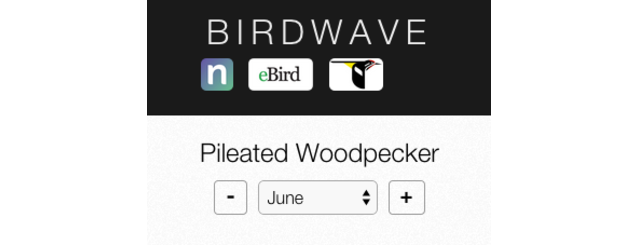Adding a Component to a ClojureScript/Om Application — a Walkthrough
Birdwave is a heavily data-driven app, which makes its UI an excellent candidate to structure into Om components. In this article, we'll add a new component to the app, and try to understand some of its inner workings in the process.
Intent of the Component
Birdwave displays month-to-month changes in the sightings of a selected species
of bird. Currently, the user can change the selected month in two ways,
depending on their device size (as noted in this post).
On larger screens there's a month slider:

And on smaller screens there's a select box with the list of available months:

It would be nice to have '+' and '-' buttons on either side of the select box for the user to go to the previous or next month without having to open the select box each time. This is exactly what we'll add in this article.

Setup
The date selector component currently looks like this:
1 2 3 4 5 6 7 8 9 10 11 | (defn date-select [model owner] (reify om/IRender (render [_] (dom/div #js {:id "slider"} (dom/div #js {:id "date-select"} (apply dom/select #js {:value (:time-period model) :onChange #(put! (om/get-state owner :time-period-ch) (.. % -target -value))} (map #(dom/option #js {:value %} (month-name %)) dates))))))) |
If you look at line 7 through 10, the component is responsible for generating a select element whose value is the currently selected time period. When a change event happens, the handler puts the new value on a core.async channel, time-period-ch, which is responsible for relaying the changes to the app state, called model.
The available dates are stored as strings in the format "YYYY/MM" in a vector named dates:
1 2 3 | (def dates #js ["2012/12" "2013/01" "2013/02" "2013/03" "2013/04" "2013/05" "2013/06" "2013/07" "2013/08" "2013/09" "2013/10" "2013/11"]) |
When a user taps on the '+', our objective is to take the current date, find the next date in the dates vector and push it onto the channel. Similarly, for the '-' button, we find the previous date and push it onto the channel.
Implementation
We can add our date-plus component as a sibling to the select element, like so (only showing lines 7 and after from the above snippet):
1 2 3 4 5 6 | (apply dom/select #js {:value (:time-period model) :onChange #(put! (om/get-state owner :time-period-ch) (.. % -target -value))} (map #(dom/option #js {:value %} (month-name %)) dates))) (om/build date-plus (:time-period model) {:state {:time-period-ch (om/get-state owner :time-period-ch)}}) |
We know that date-plus needs access to the time-period-ch, but since it is part of the app's internal state, it needs to be passed in as local state to the component. Now we can build the component itself:
1 2 3 4 5 6 7 | (defn date-plus [model owner] (reify om/IRender (render [_] (dom/span #js {:className "plus" :onClick #(update-month! model owner)} "+")))) |
As you can see, it's a simple span with the + text in it, and a click handler which calls off to an update-month! function. This is what that function looks like:
1 2 3 4 5 6 | (defn update-month! [model owner] (let [current-position (.indexOf dates model) next-month (get dates (inc (js/parseInt current-position))) time-period-ch (om/get-state owner :time-period-ch)] (when-not (nil? next-month) (put! time-period-ch next-month)))) |
The function does 3 things:
- finds the next month in the dates array by incrementing the index of the current month (which is the model that was passed in)
- retrieves the time-period-ch channel from the state set on the component
- puts the next month on the channel
It checks for nil in case the current month is the last in the array, in which case there's nothing to do.
Adding the '-' button
The '-' button works the exact same way, the only difference being that it needs to decrement the index of the current month. We can make this happen with a simple change to our update-month! function, by letting it take a function as a parameter in addition to model and owner:
1 2 3 4 5 6 | (defn update-month! [model owner func] (let [current-position (.indexOf dates model) next-month (get dates (func (js/parseInt current-position))) time-period-ch (om/get-state owner :time-period-ch)] (when-not (nil? next-month) (put! time-period-ch next-month)))) |
The function is called on the current month's index to return the next month's index. In case of date-plus, we pass in the inc function, and for date-minus, we pass in dec. This is what they look like now:
1 2 3 4 5 6 7 8 9 10 11 12 13 14 | (defn date-plus [model owner] (reify om/IRender (render [_] (dom/span #js {:id "date-plus" :onClick #(update-month! model owner inc)} "+")))) (defn date-minus [model owner] (reify om/IRender (render [_] (dom/span #js {:id "date-minus" :onClick #(update-month! model owner dec)} "-")))) |
And here's the final date selector:
1 2 3 4 5 6 7 8 9 10 11 12 13 | (defn date-select [model owner] (reify om/IRender (render [_] (dom/div #js {:id "slider"} (dom/div #js {:id "date-select"} (om/build date-minus (:time-period model) {:state {:time-period-ch (om/get-state owner :time-period-ch)}}) (apply dom/select #js {:value (:time-period model) :onChange #(put! (om/get-state owner :time-period-ch) (.. % -target -value))} (map #(dom/option #js {:value %} (month-name %)) dates)) (om/build date-plus (:time-period model) {:state {:time-period-ch (om/get-state owner :time-period-ch)}})))))) |
Conclusion
And that's it! Om's convention of isolating state makes it easy to build new interactive components with very little code (about 20 additional lines for both the + and - buttons).